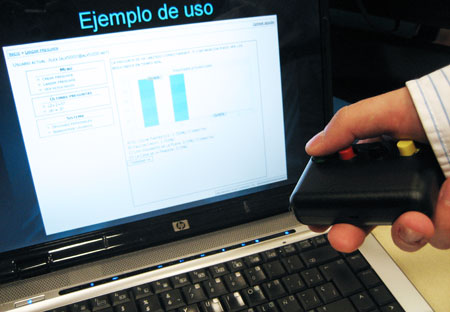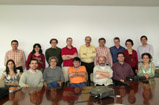|
Un estudiante de la UC idea unos mandos a distancia que fomentan la participación de los alumnos... |

|

|

|
|
Un estudiante de la UC idea unos mandos a distancia que fomentan la participación de los alumnos en clase
Los “clickers” desarrollados por Alejandro Villar para su trabajo fin de carrera se implantarán en la ETSIIT como proyecto de innovación educativa

El modelo de educación superior que conocemos está cambiando: en el espacio Bolonia, los estudiantes tienen un protagonismo creciente y son más participativos. Esto implica una adaptación de las metodologías docentes y también de los recursos materiales con los que cuentan las aulas universitarias. Un alumno de Ingeniería de Telecomunicación de la Universidad de Cantabria ha realizado su particular aportación a las tecnologías de innovación educativa aplicables al EEES con el desarrollo de unos “clickers” o mandos a distancia pensados para que los estudiantes puedan participar en las clases y contestar a las preguntas del profesor.
|
|
Leer más...
|
|
Journal: Sensors
Paper: Defect Detection in Arc-Welding Processes by Means of the Line-to-Continnuum Method and Feature Selection
AUTHORS: P.Beatriz Garcia-Allende, Jesus Mirapeix, Olga M. Conde, Adolfo Cobo, Jose M. Lopez-Higuera
Abstracts:
Plasma optical spectroscopy is widely employed in on-line welding diagnostics. The determination of the plasma electron temperature, which is typically selected as the output monitoring parameter, implies the identification of the atomic emission lines. As a consequence, additional processing stages are required with a direct impact on the real time performance of the technique. The line-to-continuum method is a feasible alternative spectroscopic approach and it is particularly interesting in terms of its computational efficiency. However, the monitoring signal highly depends on the chosen emission line. In this paper, a feature selection methodology is proposed to solve the uncertainty regarding the selection of the optimum spectral band, which allows the employment of the line-tocontinuum method for on-line welding diagnostics. Field test results have been conducted to demonstrate the feasibility of the solution. |
|
Journal: Sensors
Paper: Gas Sensor Based on Photonic Crystal Fibres in the 2v3 and v2 + 2v3 Vibrational Bands of Methane
AUTHORS: Ana M. Cubillas, Jose M. Lazaro, Olga M. Conde, Marco N. Petrovich, José M. López-Higuera
Abstracts:
In this work, methane detection is performed on the 2v3 and v2 + 2v3 absorption bands in the Near-Infrared (NIR) wavelength region using an all-fibre optical sensor. Hollowcore photonic bandgap fibres (HC-PBFs) are employed as gas cells due to their compactness, good integrability in optical systems and feasibility of long interaction lengths with gases. Sensing in the 2v3 band of methane is demonstrated to achieve a detection limit one order of magnitude better than that of the v2 + 2v3 band. Finally, the filling time of a HC-PBF is demonstrated to be dependent on the fibre length and geometry.
|
|
Journal: Applied Optics
Paper: Feasibility study of imaging spectroscopy to monitor the quality of online welding
AUTHORS: Jesús Mirapeix, P. Beatriz García-Allende, Adolfo Cobo, Olga M. Conde, José M. López-Higuera
Abstracts:
An online welding quality system based on the use of imaging spectroscopy is proposed and discussed. Plasma optical spectroscopy has already been successfully applied in this context by establishing a direct correlation between some spectroscopic parameters, e.g., the plasma electronic temperature and the resulting seam quality. Given that the use of the so-called hyperspectral devices provides both spatial and spectral information, we propose their use for the particular case of arc welding quality monitoring in an attempt to determine whether this technique would be suitable for this industrial situation. Experimental welding tests are presented, and the ability of the proposed solution to identify simulated defects is proved. Detailed spatial analyses suggest that this additional dimension can be used to improve the performance of the entire system.
|
|
<< Inicio < Anterior 21 22 23 24 25 26 27 28 29 30 Siguiente > Final >>
|
| Resultados 85 - 88 de 117 |
 Noticias
Noticias 






